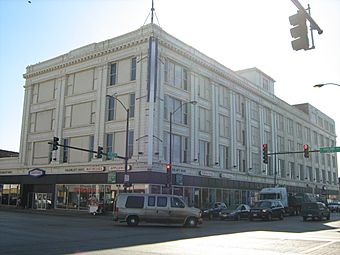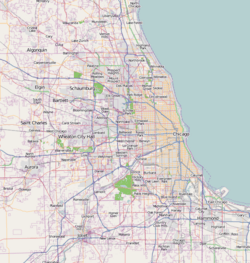Goldblatt's facts for kids
| Industry | Retail |
|---|---|
| Fate | Liquidated |
| Founded | 1914 |
| Founder | Maurice Goldblatt Nathan Goldblatt |
| Defunct | 2003 (final liquidation; all stores closed by 2000) |
| Headquarters | Chicago, Illinois, U.S. |
| Products | Clothing, footwear, bedding, furniture, jewelry, beauty products, electronics and housewares |
Goldblatt's was a well-known chain of discount stores in the United States. It started in Chicago, Illinois, in 1914. At its busiest, Goldblatt's had over twenty stores. These stores were mostly in Illinois, but also in Indiana, Michigan, and Wisconsin.
Goldblatt's was a place where families could find many different items at good prices. They sold everything from clothes and shoes to furniture, jewelry, and electronics. The company gradually closed its stores in the 1990s and finally closed completely in 2000.
Contents
How Goldblatt's Started
|
Goldblatt Bros. Department Store
|
|
 |
|
| Location | 4700 S. Ashland Ave., Chicago, Illinois |
|---|---|
| Area | less than one acre |
| Built | 1915 |
| Architect | Alfred S. Alschuler |
| Architectural style | Chicago |
| NRHP reference No. | 06001016 |
| Added to NRHP | November 15, 2006 |
Goldblatt's was founded in 1914 by two brothers, Nate and Maurice Goldblatt. They were immigrants from Poland. Before opening the store, their family ran a grocery and butcher shop in Chicago.
The brothers opened their very first Goldblatt's store near Ashland and Chicago Avenue. It quickly became popular. By 1922, the store was making over $800,000 in sales each year. In 1928, the brothers officially formed Goldblatt Brothers Inc.
During the Great Depression in the 1930s, when many businesses struggled, Goldblatt's actually did quite well. The brothers were able to buy several smaller department stores during this time.
In 1936, Goldblatt's opened a very important store on State Street in Chicago. This store was their main location. They started offering more fancy products, like small appliances, deli foods, and sweets.
Tough Times and Closing
By 1946, Goldblatt's had 15 stores and was making $62 million in sales every year. However, by the 1950s, the company's growth started to slow down. They weren't opening as many new stores as before, and their profits stayed the same.
In the mid-1960s, new types of stores like Kmart, Woolco, and Zayre became very popular. Even big stores like Sears were competing with Goldblatt's. These new stores made it harder for Goldblatt's to attract shoppers.
Goldblatt's also found it hard to open stores in the suburbs outside the city. Many middle-class families were moving to the suburbs and found other places to shop. Because of these challenges, the company had to declare bankruptcy in 1981. This means they ran out of money and couldn't pay their debts.
A New Start and Final Closure
In 1982, Goldblatt's tried to make a comeback. They reopened six of their stores. Their goal was to go back to selling affordable items to families with lower incomes.
The company's main store on State Street was going to be sold. But with help from a person named Jerrold Wexler, Goldblatt's was saved from closing completely. By 1985, the company was making money again.
However, the shopping world kept changing. There was more competition, and many of Goldblatt's stores were old. In 2000, Goldblatt's closed its doors once more. Another discount store called Ames bought seven of Goldblatt's former stores. Ames wanted to open stores in Chicago.
Later in 2000, Goldblatt's actually reopened one of its stores. They even took back four more locations when Ames closed its Chicago stores. But in 2003, Goldblatt's finally closed all its stores for good. The company sold off everything it owned.
Images for kids





